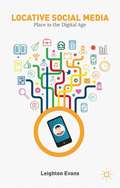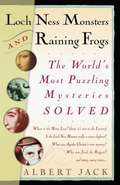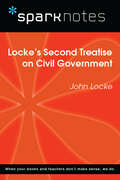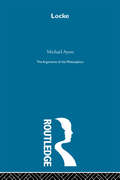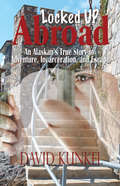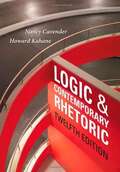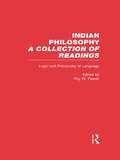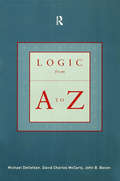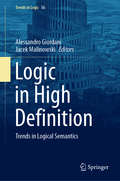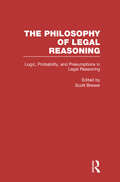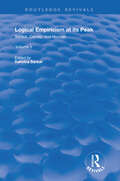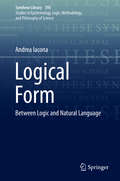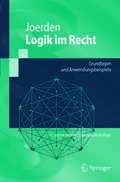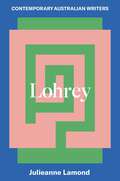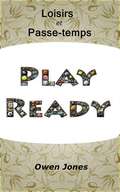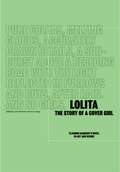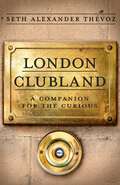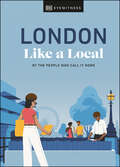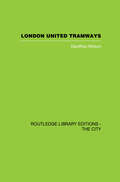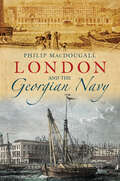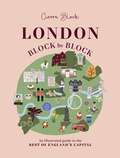- Table View
- List View
Locative Social Media
by Leighton EvansLocative Social Media offers a critical analysis of the effect of using locative social media on the perceptions and phenomenal experience of lived in spaces and places. It includes a comprehensive overview of the historical development of traditional mapping and global positioning technology to smartphone-based application services that incorporate social networking features as a series of modes of understanding place. Drawing on users accounts of the location-based social network Foursquare, a digital post-phenomenology of place is developed to explain how place is mediated in the digital age. This draws upon both the phenomenology of Martin Heidegger and post-phenomenology to encompass the materiality and computationality of the smartphone. The functioning and surfacing of place by the device and application, along with the orientation of the user, allows for a particular experiencing of place when using locative social media termed attunement, in contrast to an instrumentalistconception of place.
Loch Ness Monsters and Raining Frogs: The World's Most Puzzling Mysteries Solved
by Albert JackFOOLED BY FABLES? LED ON BY LEGENDS? MYTH-GUIDED? WONDER NO MORE, MYSTERY-PHILES: THE TRUTH IS IN HERE! What in the world (or out of it) made those giant crop circles? Did skydiving skyjacker D. B. Cooper really get away with it? Is Bigfoot a big fake? Are ETs just BS? If you're tired of scratching your head over persistent puzzlers like these, mystery-buster Albert Jack has the cure for your quizzical itch. He's gone hunting for the truth behind more than thirty of the most famous and baffling conundrums in history. Did a conspiracy or a calamity kill Marilyn Monroe? Is the Bermuda Triangle a tropical tall tale? Was a dead Paul McCartney replaced by a doppelgänger? How did Edgar Allan Poe meet his doom? In quick-witted entries on each enigmatic topic, Loch Ness Monsters and Raining Frogs offers answers certain to surprise, enlighten, amuse, and perhaps disappoint true believers. But Albert Jack never fails to fascinate and entertain as he spills the beans about the odd, the eerie, and the (no longer) unexplained.
Locke's Second Treatise on Civil Government (SparkNotes Philosophy Guide)
by SparkNotesLocke's Second Treatise on Civil Government (SparkNotes Philosophy Guide) Making the reading experience fun! SparkNotes Philosophy Guides are one-stop guides to the great works of philosophy–masterpieces that stand at the foundations of Western thought. Inside each Philosophy Guide you&’ll find insightful overviews of great philosophical works of the Western world.
Locke-Arg Philosophers (Arguments Of The Philosophers Ser. #12)
by Michael AyersFirst published in 1999. Routledge is an imprint of Taylor & Francis, an informa company.
Locked Up Abroad: An Alaskan's True Story of Adventure, Incarceration, and Escape.
by David KunkelLocked Up Abroad is a true story of a young drug dealer and his friend turned smugglers. His shoe-string caper covered 6,000 miles from Europe to Afghanistan to Greece. The high of quick money morphed into capture. A Corrupt judicial system introduced them to a hellish 200-year-old island prison fortress. The only way out of the this devil's den was escape. Locked Up Abroad is a convincing statement of the perils of illegal drugs and unlawful activity. Only the author escaped. His companions either died in prison or are still doing time.
Log Cabins and Outbuildings: A Guide to Building Homes, Barns, Greenhouses, and More
by The United States Department of AgricultureHomesteading is a lifestyle that people around the world gravitate toward—and for good reason. In today&’s high-stress world, many people dream of heading off to their own cabin in the woods or to their large rural oasis to escape the anxieties and complexities of daily life, to live in a more natural state. Others have embraced the agricultural lifestyle of farming as a career, serving as fundamental contributors to sustaining society. With this classic guide from the US Department of Agriculture (USDA), learn about the architecture of rural life and the design elements of these amazing structures. This manual, originally published and distributed in 1972, includes government-issued designs and requirements for log cabins, farmhouses, firepits and barbecues, greenhouses, storage sheds, stables, and more! Black-and-white diagrams and illustrations fill these pages, displaying the intricacies and dimensions of these incredible structures in their entirety. Brimming with ideas and inspiration, Log Cabins and Outbuildings is the perfect starting point for building your new rural retreat.
Logic and Contemporary Rhetoric: The Use of Reason in Everyday Life
by Nancy M. Cavender Howard KahaneThis classic text, first published in 1971, has introduced tens of thousands of students to sound reasoning using a wealth of current, relevant, and stimulating examples all put together and explained in Howard Kahane's uniquely witty and invigorating writing style. Long the choice of instructors who want to "keep students interested", LOGIC AND CONTEMPORARY RHETORIC combines examples from TV, newspapers, magazines, advertisements, and, in typical Kahanian fashion, our nation¹s political dialogue. The text not only brings the concepts alive for students, but puts critical thinking skills into a context that students will retain and use throughout their lives. This is a book you can actually count on students to read.
Logic and Language: Indian Philosophy (Problems Of Philosophy Ser. #Vol. 2)
by Roy PerrettFirst published in 2001. Routledge is an imprint of Taylor & Francis, an informa company.
Logic from A to Z: The Routledge Encyclopedia of Philosophy Glossary of Logical and Mathematical Terms
by John B. Bacon Michael Detlefsen David Charles McCartyFirst published in the most ambitious international philosophy project for a generation; the Routledge Encyclopedia of Philosophy.Logic from A to Z is a unique glossary of terms used in formal logic and the philosophy of mathematics.Over 500 entries include key terms found in the study of:* Logic: Argument, Turing Machine, Variable* Set and model theory: Isomorphism, Function* Computability theory: Algorithm, Turing Machine* Plus a table of logical symbols.Extensively cross-referenced to help comprehension and add detail, Logic from A to Z provides an indispensable reference source for students of all branches of logic.
Logic in High Definition: Trends in Logical Semantics (Trends in Logic #56)
by Jacek Malinowski Alessandro GiordaniThis volume clusters together issues centered upon the variety of types of intensional semantics. Consisting of 10 contributions, the volume is based on papers presented at the Trends in Logic 2019 conference. The various chapters introduce readers to the topic, or apply new types of logical semantics to elucidate subtleties of logical systems and natural language semantics.The book introduces hyperintentional systems that aim at solving some open philosophical problems. Specifically, the first three studies focus on relating semantics, while the following ones discuss fundamental issues related to hyper-intensional semantics or develop hyper-intensional frameworks to address issues in modal, epistemic, deontic and action logic. Authors in this volume present original results on logical systems but also extend beyond this by offering philosophical considerations on the topic as well. This volume will appeal to students and researchers in the field of logic.
Logic, Probability, and Presumptions in Legal Reasoning: A Collection Of Essays By Philosophers And Legal Scholars: Logic, Probability, And Presumptions In Legal Reasoning (Philosophy of Legal Reasoning: A Collection of Essays by Philosophers and Legal Scholars #No. 1)
by Scott BrewerAt least since plato and Aristotle, thinkers have pondered the relationship between philosophical arguments and the "sophistical" arguments offered by the Sophists -- who were the first professional lawyers. Judges wield substantial political power, and the justifications they offer for their decisions are a vital means by which citizens can assess the legitimacy of how that power is exercised. However, to evaluate judicial justifications requires close attention to the method of reasoning behind decisions. This new collection illuminates and explains the political and moral importance in justifying the exercise of judicial power.
Logical Empiricism at Its Peak: Schlick, Carnap, and Neurath (Science And Philosophy In The Twentieth Century: Basic Works Of Logical Empiricism Ser. #2)
by Sahotra Sarkar Rudolf Carnap Maria Neurath Moritz SchlickFirst Published in 1996. This volume reprints pieces from the Vienna Circle period between the manifesto and the adoption of semantics, as well as two commentaries. During this period, the logical empiricists were the most ambitious and the most confident about the success of their enterprise. The first section consists of four ideological classics, The second section reprints three papers on physicalism. The third section consists of three papers on logic and the fourth on reprints three papers on truth, induction, and confirmation.
Logical Form: Between Logic and Natural Language (Synthese Library #393)
by Andrea IaconaLogical form has always been a prime concern for philosophers belonging to the analytic tradition. For at least one century, the study of logical form has been widely adopted as a method of investigation, relying on its capacity to reveal the structure of thoughts or the constitution of facts. This book focuses on the very idea of logical form, which is directly relevant to any principled reflection on that method. Its central thesis is that there is no such thing as a correct answer to the question of what is logical form: two significantly different notions of logical form are needed to fulfill two major theoretical roles that pertain respectively to logic and to semantics. This thesis has a negative and a positive side. The negative side is that a deeply rooted presumption about logical form turns out to be overly optimistic: there is no unique notion of logical form that can play both roles. The positive side is that the distinction between two notions of logical form, once properly spelled out, sheds light on some fundamental issues concerning the relation between logic and language.
Logik im Recht
by Jan C. JoerdenIn dem Lehr- und Studienbuch zeigt der Autor, in welchem Maße logische Strukturen das Rechtsdenken bestimmen. Er erläutert die wesentlichen logischen Grundlagen und ihre Anwendung auf dem Gebiet des Rechts. Zum einen führt dies zu einem tieferen Verständnis der juristischen Dogmatik und einer systematischen Durchdringung des Rechtsstoffs, zum anderen tragen die Überlegungen zwischen Logik und Rechtswissenschaft zu neuen Erkenntnissen bei. Behandelt werden verschiedene Strukturen des Rechts, u. a. relationenlogische und syllogistische Strukturen.
Lohrey
by Julieanne LamondAmanda Lohrey is a fearless and idiosyncratic writer whose award-winning career spans four decades. Her work is experimental, political, intimate and compelling. Lohrey provides an illuminating series of readings of key preoccupations across Lohrey's body of work. From the relationship of the personal to the political, masculinity and free will, human and non-human worlds and how reading shapes us, Lohrey traces a remarkable career across the contemporary literary landscape, and provides readers with an understanding of Lohrey's bold and singular style.
Loisirs et passe-temps (Comment faire... #55)
by Owen JonesBonjour, et merci d’avoir acheté ce livre numérique appelé “Loisirs et passe-temps” J'espère que vous trouverez ces informations instructives, utiles et intéressantes. Les informations données dans ce livre concernent divers aspects des loisirs, passe-temps et autres activités. Elles sont organisées en 16 chapitres d’environ 500-600 mots chacun. J’espère qu’elle intéresseront ceux d’entre vous qui aiment faire quelque chose de leur temps libre. Petit bonus : je vous autorise à en utiliser le contenu sur votre propre site, blog ou bulletin d’information, même s’il est préférable de le réécrire avec vos propres mots. Vous pouvez aussi diviser le livre et en revendre certains articles. De fait, le seul droit dont vous ne disposez pas est de revendre le livre tel quel. Si vous souhaitez me faire part de vos réactions, contactez le fournisseur qui vous a vendu le livre. Merci encore d’avoir acheté ce livre numérique. Cordialement Owen Jones
Lolita - The Story of a Cover Girl
by Yuri Leving John BertramWhat should Lolita look like? The question has dogged book-cover designers since 1955, when Lolita was first published in a plain green wrapper. The heroine of Vladimir Nabokov's classic novel has often been shown as a teenage seductress in heart-shaped glasses--a deceptive image that misreads the book but has seeped deep into our cultural life, from fashion to film. Lolita - The Story of a Cover Girl: Vladimir Nabokov's Novel in Art and Design reconsiders the cover of Lolita. Eighty renowned graphic designers and illustrators (including Paula Scher, Jessica Hische, Jessica Helfand, and Peter Mendelsund) offer their own takes on the book's jacket, while graphic-design critics and Nabokov scholars survey more than half a century of Lolita covers. You'll also find thoughtful essays from such design luminaries as Mary Gaitskill, Debbie Millman, Michael Bierut, Peter Mendelsund, Jessica Helfand, Alice Twemlow, Johanna Drucker, Leland de la Durantaye, Ellen Pifer, and Stephen Blackwell. Through the lenses of design and literature, Lolita - The Story of a Cover Girl tells the strange design history of one of the most important novels of the 20th century--and offers a new way for thinking visually about difficult books. You'll never look at Lolita the same way again.
Lolita - The Story of a Cover Girl: Vladimir Nabokov's Novel in Art and Design
by John BertramWhat should Lolita look like? The question has dogged book-cover designers since 1955, when Lolita was first published in a plain green wrapper. The heroine of Vladimir Nabokov's classic novel has often been shown as a teenage seductress in heart-shaped glasses--a deceptive image that misreads the book but has seeped deep into our cultural life, from fashion to film.Lolita - The Story of a Cover Girl: Vladimir Nabokov's Novel in Art and Design reconsiders the cover of Lolita. Eighty renowned graphic designers and illustrators (including Paula Scher, Jessica Hische, Jessica Helfand, and Peter Mendelsund) offer their own takes on the book's jacket, while graphic-design critics and Nabokov scholars survey more than half a century of Lolita covers. You'll also find thoughtful essays from such design luminaries as Mary Gaitskill, Debbie Millman, Michael Bierut, Peter Mendelsund, Jessica Helfand, Alice Twemlow, Johanna Drucker, Leland de la Durantaye, Ellen Pifer, and Stephen Blackwell.Through the lenses of design and literature, Lolita - The Story of a Cover Girl tells the strange design history of one of the most important novels of the 20th century--and offers a new way for thinking visually about difficult books. You'll never look at Lolita the same way again.
London Clubland: A Companion for the Curious
by Seth Alexander ThévozStep into the hidden world of London's private members' clubs with London Clubland: A Companion for the Curious. This guide, by the leading historian on the subject, offers a fascinating insight into these legendary institutions. Culture, history and traditions are all explained - from aristocratic haunts like Boodle's and Brooks's, to modern icons like Soho House and the Groucho Club.Insightful and entertaining, London Clubland is your ultimate guide and almanac to this world, from navigating the application process, to the unwritten rules that define these spaces - not to mention a wealth of trivia assembled over twenty years. Readers will discover mottos, maps, songs and club recipes, as well as little-known facts that some of London's most iconic clubs probably wouldn't want you to know.Whether you are a long-standing member, a reciprocal visitor, an aspiring applicant, or simply just curious about this secretive world, London Clubland offers an engaging and revealing tour through some of London's most discreet institutions.
London Clubland: A Companion for the Curious
by Seth Alexander ThévozStep into the hidden world of London's private members' clubs with London Clubland: A Companion for the Curious. This guide, by the leading historian on the subject, offers a fascinating insight into these legendary institutions. Culture, history and traditions are all explained - from aristocratic haunts like Boodle's and Brooks's, to modern icons like Soho House and the Groucho Club.Insightful and entertaining, London Clubland is your ultimate guide and almanac to this world, from navigating the application process, to the unwritten rules that define these spaces - not to mention a wealth of trivia assembled over twenty years. Readers will discover mottos, maps, songs and club recipes, as well as little-known facts that some of London's most iconic clubs probably wouldn't want you to know.Whether you are a long-standing member, a reciprocal visitor, an aspiring applicant, or simply just curious about this secretive world, London Clubland offers an engaging and revealing tour through some of London's most discreet institutions.
London Like a Local: By the People Who Call It Home (Local Travel Guide)
by Florence Derrick Marlene Landu Olivia PassKeen to explore a different side of London? Like a Local is the book for you.This isn&’t your ordinary travel guide. You won&’t find the London Eye or Buckingham Palace in these pages, because that&’s not where Londoners hang out. Instead, you&’ll meet the locals at hidden record shops, cosy pubs and indie galleries – and that&’s where this book takes you. Turn the pages to discover: The small businesses and community strongholds that add character to this vibrant city, recommended by true locals.6 themed walking tours dedicated to specific experiences such as street art and brewing history.A beautiful gift book for anyone seeking to explore London.Helpful &‘what3word&’ addresses, so you can pinpoint all the listed sights.A thoughtfully updated second edition, including new sights to discover.Compiled by three proud Londoners and revised and updated for 2023, this stylish travel guide is packed with London&’s best experiences and secret spots, handily categorized to suit your mood and needs.Whether you&’re a restless Londoner on the hunt for a new hangout, or a visitor keen to discover a side you won&’t find in traditional guidebooks, London Like A Local will give you all the inspiration you need. About Like A Local:These giftable and collectible guides from DK Eyewitness are compiled exclusively by locals. Whether they&’re born-and-bred or moved to study and never looked back, our experts shine a light on what it means to be a local: pride for their city, community spirit and local expertise. Like a Local will inspire readers to celebrate the secret as well as the iconic – just like the locals who call the city home. Looking for another guide to London? Explore further with our DK Eyewitness or Top 10 guides to London.
London United Tramways: A History 1894-1933
by Geoffrey WilsonWith the twentieth century arrived the first electric tramcars in London. Thirty years later the first trolley buses arrived - along with a fleet of new trams that were the most modern of their day. This era was one of rapid change, rich in achievement adn personalities. Among the more colourful of the undertakings involved was London United, which introduced the first public service of electric tramcars in 1901 adn became one of the predecessors of the present London Transport. This is a study of this eventful period, relating the development of the tramway and trolleybus system to the changing social background. It contains a wealth of hitherto unpublished material, both factual and anecdotal, taken from contemporary newspaper and other accounts, and a remarkable collection of illustrations - 48 pages in all. It should be of interest not only to the transport enthusiast but also to the general reader interested in social history. This book was first published in 1971.
London and the Georgian Navy
by Philip MacDougall Philip MacdougallAt a time when the Royal Navy was the biggest and best in the world, Georgian London was the hub of this immense industrial-military complex, underpinning and securing a global trading empire that was entirely dependent on the navy for its existence. Philip MacDougall explores the bureaucratic web that operated within the wider city area before giving attention to London’s association with the practical aspects of supplying and manning the operational fleet and shipbuilding, repair and maintenance. His supremely detailed geographical exploration of these areas includes a discussion of captivating key personalities, buildings and work. The book examines significant locations as well as the importance of Londoners in the manning of ships and how the city memorialised the navy and its personnel during times of victory. An in-depth gazetteer and walking guide complete this fascinating study of Britain, her capital and her Royal Navy.
London's Statues and Monuments
by Peter MatthewsThe streets and public spaces of London are rich with statues and monuments commemorating the great people of history. From the monumental Nelson's Column in Trafalgar Square and Sir Christopher Wren's Great Fire Monument to the charming Peter Pan statue in Kensington Gardens, and the bronze of Paddington Bear on the lawn of the railway station that gave him his name, the range of London's statues and monuments is huge. Some commemorate events, while others celebrate people, real and fictional. Some take the form of small reliefs, while others are huge pedimented bronzes, larger than life size. Executed in stone, bronze and a range of other materials, London's statues and monuments include work by some of the greatest sculptors.Shire first published a book on this subject in 1968, and for forty years it was a stalwart of the list, opening the eyes of countless Londoners and visitors to the capital to the sculptural splendour of the city. Peter Matthews has now produced an entirely new book on the subject, reorganised, rewritten, and reillustrated with a completely new set of specially taken photographs. Over 500 statues and monuments feature in this indispensible guide, and fascinating information about the sculptors and the stories behind the monuments make this book a uniquely useful resource for anyone wanting to gain a deeper insight into these wonderful adornments to the streets of the capital.
London, Block by Block: An illustrated guide to the best of England’s capital (Block by Block)
by Cierra BlockFor anyone who loves London – whether you're visiting for the weekend or are a die-hard local – this is the book for you.Artist Cierra Block loves to create maps, and this compilation will have you uncovering the best things London has on offer. Featuring the most notable places to eat, what to see, where to walk and what to do, this is a guide like no other. Vibrantly illustrated, Cierra lists all the top addresses and areas to explore. Find out where to indulge in the best afternoon tea and festive mince pies; jump on a bike and take a spin around Shoreditch or Hampstead like a local; or follow in the footsteps of the Suffragettes. From haunted spots for true-crime lovers, to the best bookshops, romantic strolls and coffee pit-stops, London, Block by Block will make your next visit to London the most memorable one yet.
